The eggs and eggshells of birds have been a source of fascination for humans for centuries. In particular, the colours and patterning that are found on the outer surface of the shell have long been a point of discussion among scientists, historians and birders alike. The beauty of eggshells has long been their downfall, with egg collectors contributing to the decline of many species over the last 200 years. Although the collection of wild bird eggs was made illegal in 1954, sadly this despicable activity still takes place.
Indeed, the danger posed by eggs being illegally taken today is why the nests of rare species are still often kept secret or heavily guarded. Any eggs now confiscated from illegal collections, intercepted upon entry to or exit from the United Kingdom, or originating from legacy collections hidden away in people's lofts, now go to the Natural History Museum at Tring, Hertfordshire, which holds the largest collection of eggshells in the world. The collection comprises more than a million eggs, including those of many rare and extinct species, and provides a valuable resource for research.
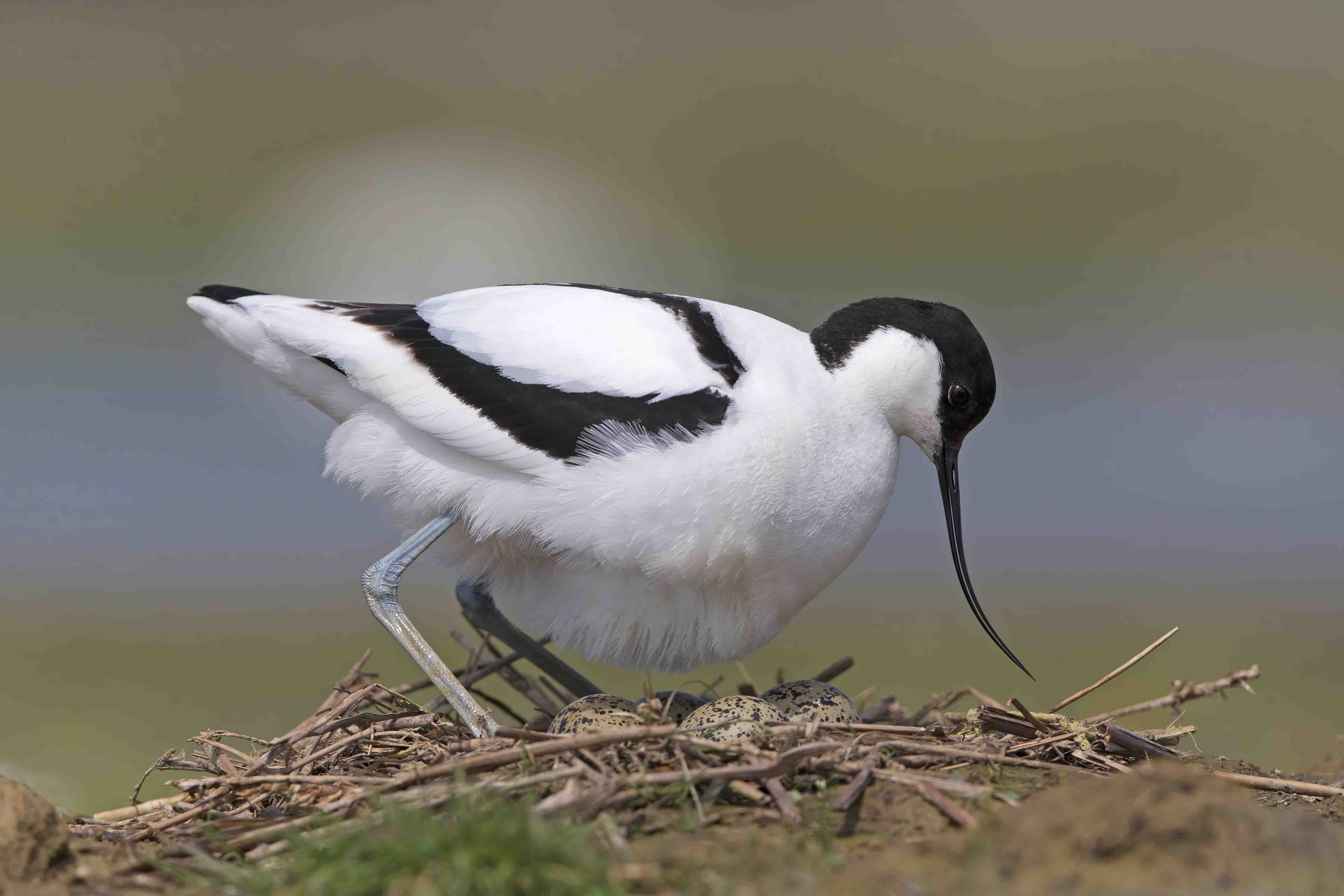
After a clutch of eggs has been laid it is essentially impossible for the parent birds, such as this Avocet, to move them. As a result, the eggs have to deal with whatever the elements throw at them (Paul Sawer).
Shell pigments
From the magical, celestial appearance of a Guira Cuckoo egg to the extreme brightness and glossiness of the eggs of Great Tinamou, the variety of colours and patterns exhibited by bird eggshells is quite exceptional. The eggs of reptiles and dinosaurs are immaculate; to the human eye, they are white with no obvious pigment present. The intricate eggshell designs and the array of colours we see are, therefore, unique to birds and their eggs.
What makes these vibrant patterns – known as maculation – even more remarkable is that all the colours seen on bird eggshells are the result of just two pigments: protoporphyrin and biliverdin. The reddish-brown hues are a result of the protoporphyrin, while blue-green colours originate from biliverdin. Even immaculate eggs that appear completely white still have minute traces of pigment present within the shell.
These pigments are synthesised by the females, thus producing pigmentation is an energetically costly act. Therefore, these pigments – and the speckling, colours and patterns they produce – must provide important functions. The purpose of pigmentation has long been an area of great debate, but before we understand its role, first we must consider what a bird egg actually is.
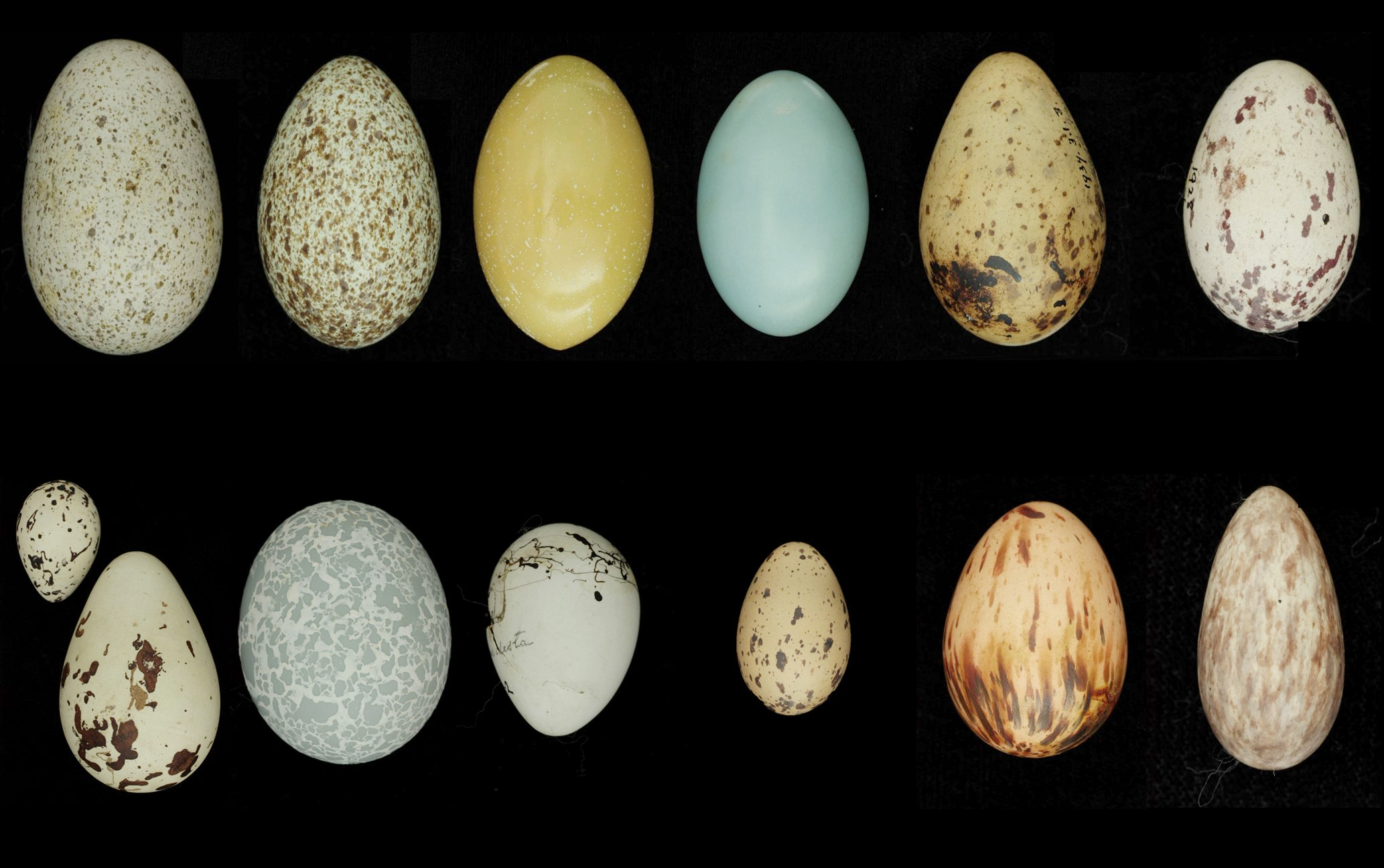
The above image portrays some of the wide variety of egg sizes and colours found among different species. Egg sizes range from approximately 1.4 kg for Common Ostrich to a tiny 0.4 g for Vervain Hummingbird (G Murer).
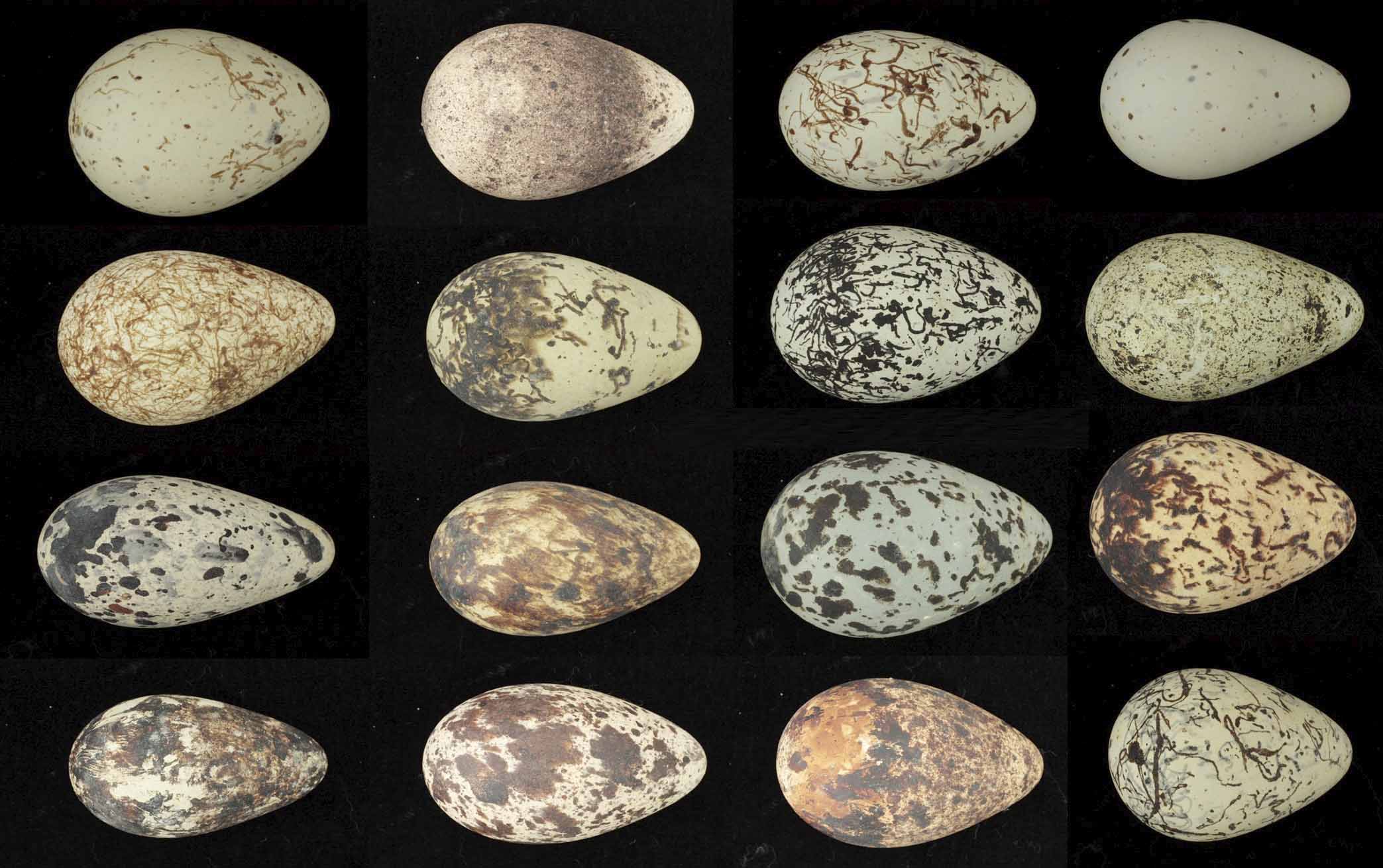
This photo depicts the variety of different colours and patterns found within a range of eggs of just one species: Guillemot. These conical eggs help to prevent them rolling off steep cliff edges. Guillemot eggs are also water-repellent and self-cleaning (G Murer).
What are eggshells?
Birds breed on all seven continents on Earth: at altitudes greater than 4,000 m above sea level, in temperatures ranging between -40°C and +50°C, and in environments varying from water-saturated marshes to the driest of deserts. Egg size can range from 1.4 kg for Common Ostrich to 0.4 g for Vervain Hummingbird, while the clutch size can vary from a single egg to broods of more than 20. Despite this high variation in environmental conditions and life-history traits, producing eggs with viable young is a necessity for all bird species in order to reproduce and persist. Thus, bird eggs need to be adapted to their environment, both that of the nest and the wider area.
The avian egg and eggshell are a complex, multifunctional bioceramic made predominantly from calcium, that protects the developing embryo inside from mechanical damage and infection while providing calcium for bone growth and ensuring the correct exchange of respiratory gases.
Once laid, it is virtually impossible for eggs to be moved by the parent birds, thus the eggs must contend with whatever the elements throw at them. This can include extreme weather, wetting, dirt, parental faecal matter and predators. The eggshell also needs to cope with the potential mechanical damage caused by collisions with other eggs in the nest. What eggshells are achieving, therefore, is truly remarkable.
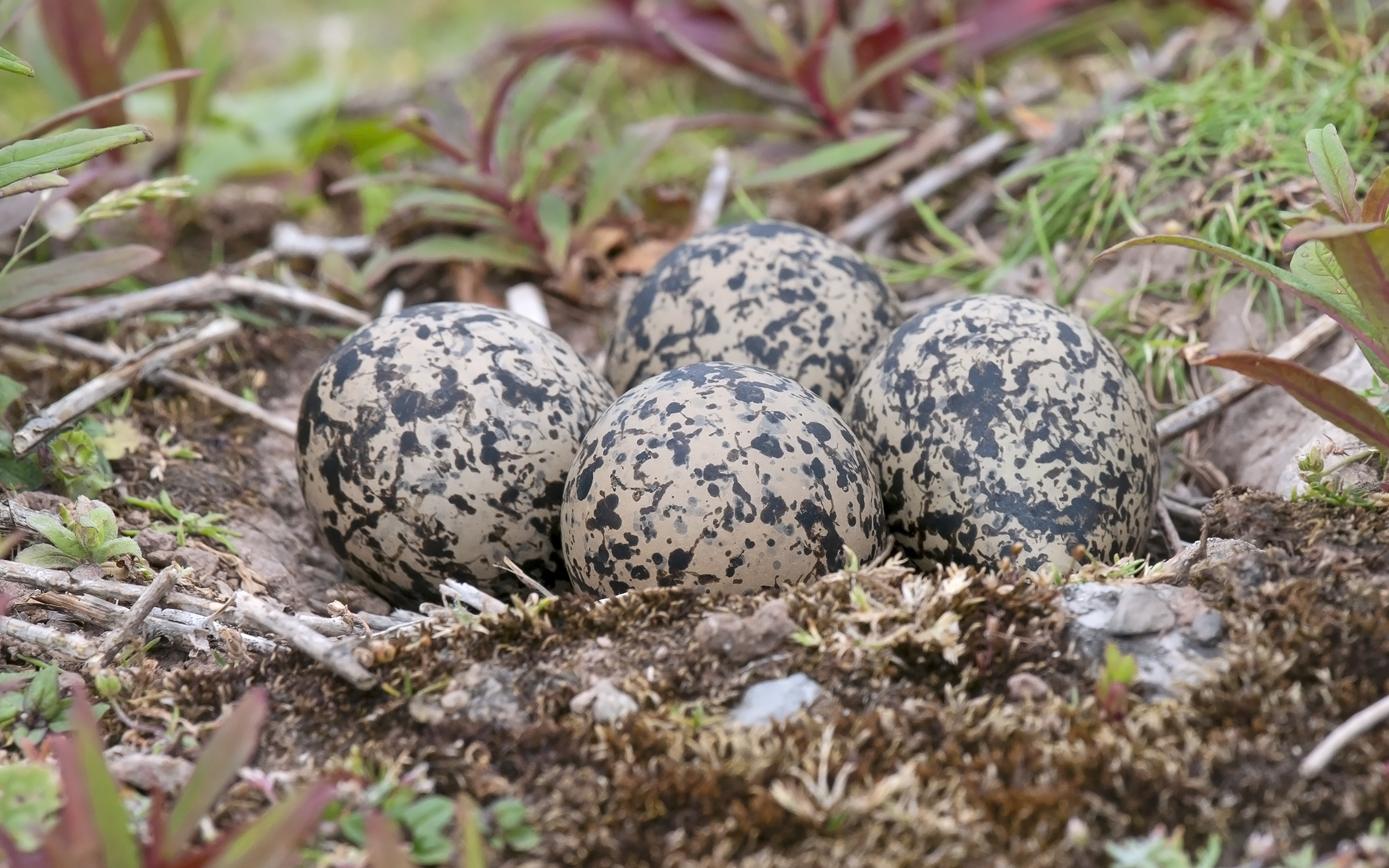
Northern Lapwings lay clutches of four cryptically coloured eggs from late March to early June. Chicks hatch between three and four weeks later (Steve Young).
The function of colour
Eggshell pigmentation performs a multitude of functions, often closely linked to the environment within which the eggs are laid. For birds nesting in open locations, the eggs may have to contend with exposure to the sun, both the heating infrared wavelengths and the mutagenic ultraviolet light. The amount of light that an egg receives will vary greatly depending on the habitat, the location of the nest and the incubatory behaviour of the parents.
Light levels can vary greatly depending on the placement of the nest and the habitat itself. For example, light levels can range from 1,000 lux under a forest canopy to more than 100,000 lux on an exposed beach. At worst, overheating of the eggs destroys the developing embryo inside, while at best, it causes developmental abnormalities and deformities.
One function of pigmentation, therefore, is to control and filter the amount of light penetrating the eggshell and reaching the embryo inside, while regulating the temperature of the egg. It is no coincidence that birds such as woodpeckers, parrots and owls, which nest in tree cavities and burrows away from the potentially damaging effects of the sun, have eggs which are typically immaculate with little to no pigment present. In contrast, species nesting in exposed environments often have eggs that are heavily pigmented, particularly with red-brown colours.
There are, of course, always interesting contradictions that don't fit this pattern. One of the most bizarre examples of this can be found between Common Ostrich and Emu, two closely related species. Both largely exhibit a similar lifestyle – nesting in exposed environments – yet the eggs of Common Ostrich are pristine white, while those of the Emu are a rich dark green.

These microscope images illustrate different eggshell surface structures (Dr Steven Portugal).
Another function of pigmentation is crypsis, or providing camouflage for the egg in the absence of an incubating parent. The requirement for camouflage is again closely linked to the location of the nest and its general surrounding environment and habitat. Heavily pigmented eggs are most commonly found in species nesting in more open environments such as heathlands, meadows and beaches, where camouflage is essential when the eggs are left unattended, even for a very brief period.
Indeed, maculation on the eggshells of some species, such as those found in Ringed Plovers, is so effective at camouflage that the eggs are almost impossible to spot against the shingle background. As camouflage plays no role in protecting the eggs of species nesting in cavities and burrows, again we see no obvious pigment in those eggs. An exciting additional function of eggshell pigmentation, which research is only just beginning to discover, is its antimicrobial properties. When activated by light, protoporphyrin reduces the survival of gram-positive bacteria.
The brighter the better
Eggshell pigmentation can also play a role in sexual signalling. For example, it has been suggested that the extent of the blueness that a female Pied Flycatcher exhibits in her eggshell is a sexual signal to the male of her quality, and the likely quality of their shared offspring. Pied Flycatchers exhibit a polygamous mating system, whereby a male will have multiple females he has bred with and is provisioning for during the breeding season.
Thus, a female exhibiting extremely blue eggs is communicating her overall condition to solicit more provisioning from the male. This blue egg, and the concentration of the pigment biliverdin, has been shown to be linked to the health of the female, so could be considered an honest signal.
Intricate patterning on bird eggshells is also thought to help individuals recognise their own eggs. In Guillemots, for example, it is thought that each egg has a completely unique pattern that helps to ensure the parents do not incubate the wrong egg when they return from foraging trips or are swapping incubation duties.
Being able to recognise your own eggs can also play an important role in avoiding being the victim of brood parasites. Avian brood parasites, such as cuckoos, cowbirds and Cuckoo-finch, are birds that lay their eggs in the nests of other species, known as hosts, forcing them to raise the parasitic offspring.
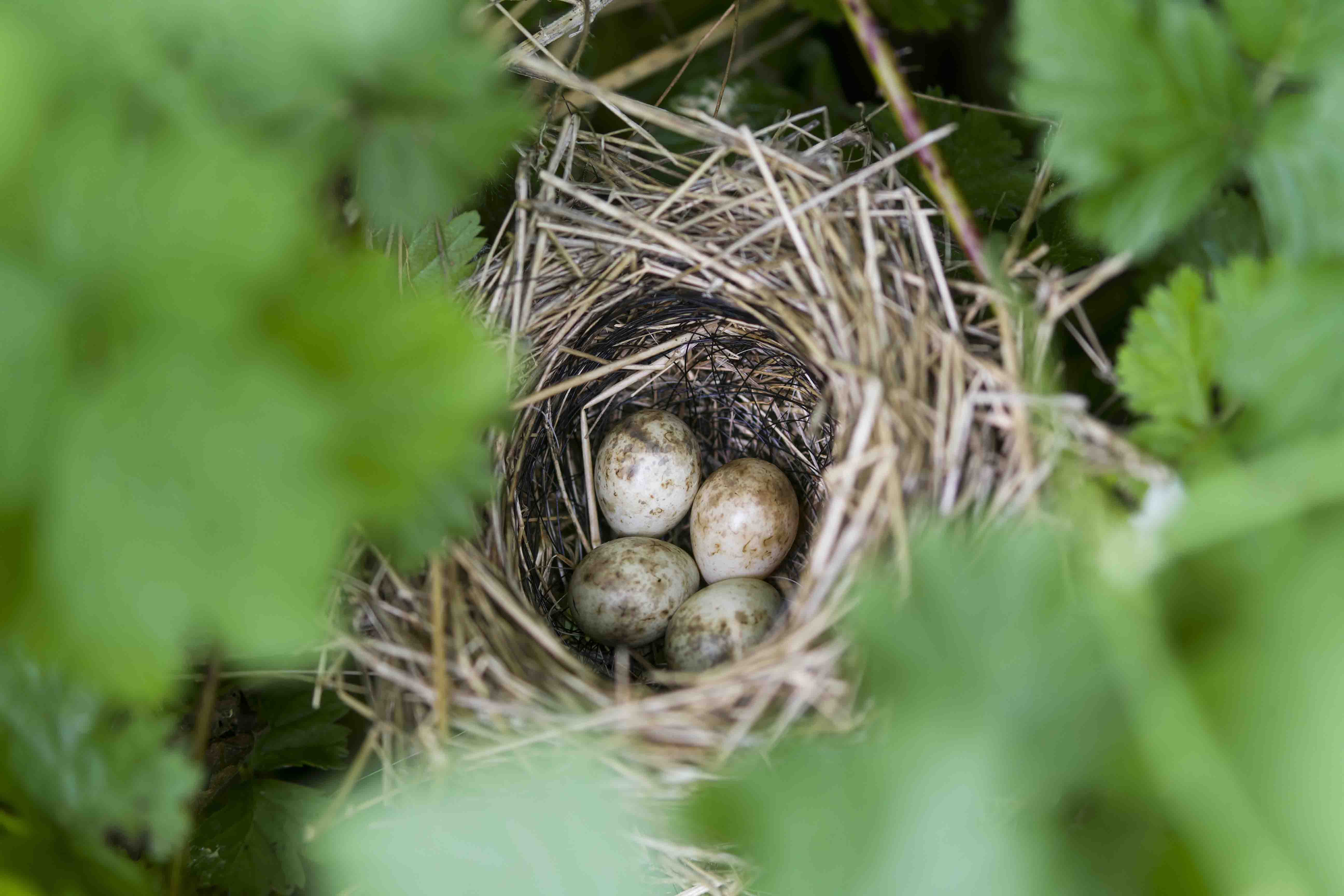
Garden Warblers lay four to five whitish eggs with olive-brown marks. Both adults incubate the eggs for 11-13 days and the young are fed by both parents (Paul Sawer).
Part of the deception begins with their eggshell patterning, which mimics that of their hosts. The more intricate the patterning of the host egg, the harder it is for the parasite to mimic. Eggshell mimicry has long been considered an example of a co-evolutionary arms race, whereby the parasite is continually trying to be more effective at mimicking the host eggs, while the hosts are trying to make it more difficult for the parasites to do so.
Thus, being able to recognise your own egg has a real advantage when trying to detect an invasive parasite. Fascinating recent research has shown that females of certain passerines have a distinct signature in their pigmentation patterns that is unique to the individual, and this is thought to be a mechanism to assist in self-egg recognition and spot any egg intruders in the nest.
Egg surface structures
The surface structure of the eggshell varies greatly between species, and it is this structure that can influence how an egg looks, and also how it responds to different environmental conditions. For example, the glossy appearance of Great Tinamou eggshells is produced by an extremely smooth cuticle causing light to reflect in the specular direction, whereas the matt appearance of domestic chicken eggs is produced by having a rough cuticle, causing light to be scattered in multiple directions. Unusually, tinamou eggshells are known to contain two additional pigments, uroerythrin and bilirubin, the function of which is not yet entirely clear.
The eggs of Greater Ani are also particularly curious. They contain the rare mineral, vaterite – a thermodynamically unstable polymorph of calcium carbonate – one function of which appears to be to act as a shock absorber for the underlying calcite shell, protecting the developing embryo. Breeding in Greater Anis is slightly odd, in that a single nest can contain eggs from up to four females, who then co-operatively provide care to the communal clutch.
Vaterite is believed to be present in the shells of Greater Anis as a direct result of their large clutch size, and the substantial forces exerted during egg turning, causing the eggs to collide. The presence of vaterite suggests, in this instance, that selection has favoured adaptations that reduce the risk of shell fracture. This is particularly extraordinary considering vaterite is more typically found in meteorites and marine molluscs.
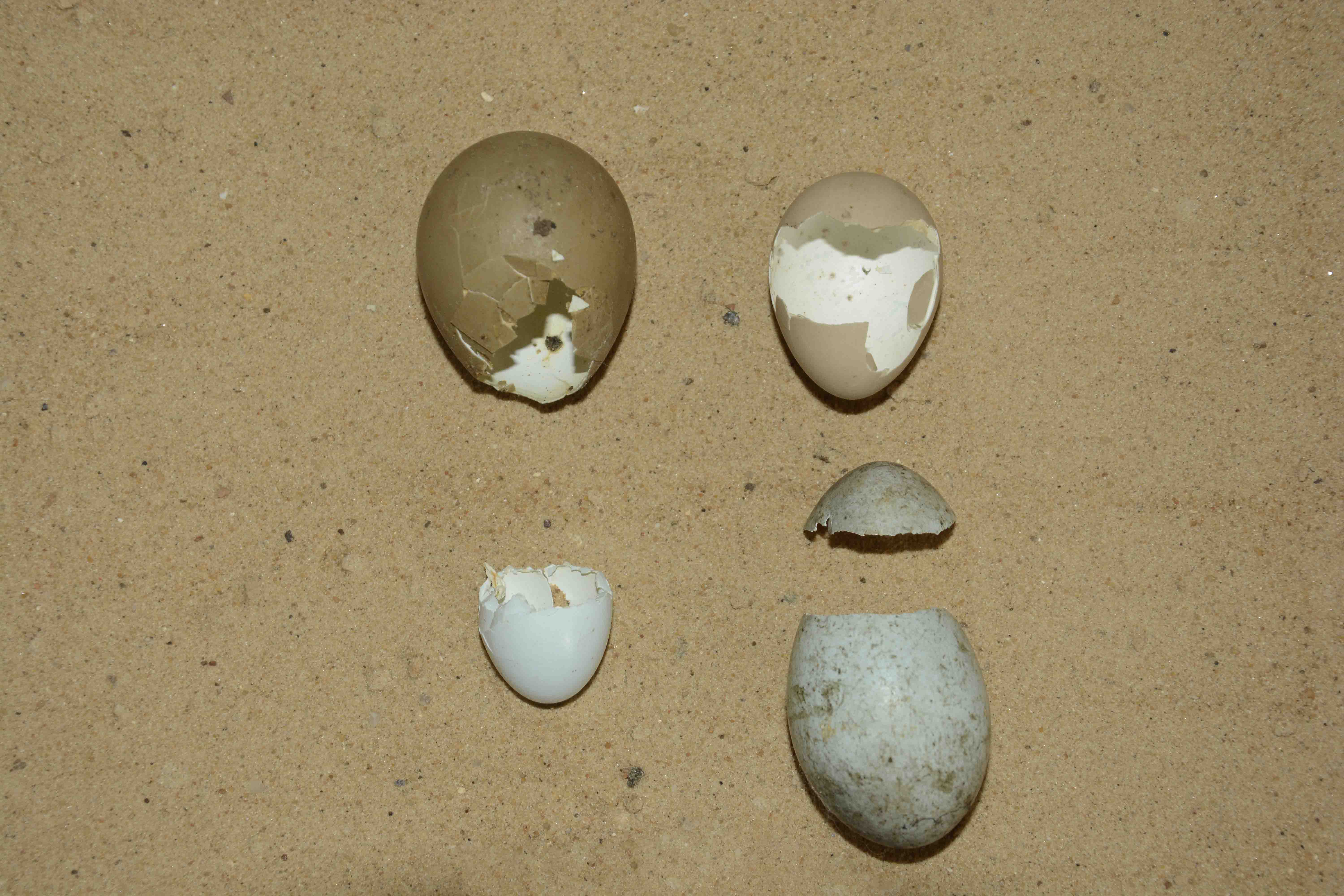
Predated eggs of Common Pheasant and Grey Partridge (top row) and hatched eggs of Common Starling and Carrion Crow (bottom row) (Moss Taylor).
Health factors
Because of the wide array of environments and habitats that birds breed in, the eggshell structure needs to be finely tuned to survive the nest and ambient environment. For many species, dirt and general detritus are a real problem; bird nests are not particularly sanitary! Parents can introduce dirt when they return to the nest, or they can return wet if the adults are aquatic foraging species. The outer surface of the eggshell can help fight against the possible risk of infection and prevent the pores from getting blocked with mess and water.
The pores are the vital lifeline passing through the shell, bringing oxygen to the developing embryo, while permitting carbon dioxide and water vapour to leave. Those species which nest in particularly damp or humid environments, such as those over water or in enclosed spaces, exhibit small nanoscale (a nanometre is a billionth of a metre) cone-like structures, which alter how water behaves on the surface of the eggshell.
These structures cause the eggshell surface to be hydrophobic, meaning water beads up on the surface without spreading out. This prevents the pores from getting blocked, and can also trap dirt particles, which fall off the shell with the water droplet. Species nesting in warm climates are more likely to exhibit highly hydrophobic eggshells than those nesting in cold climates, potentially reducing microbial colonisation.
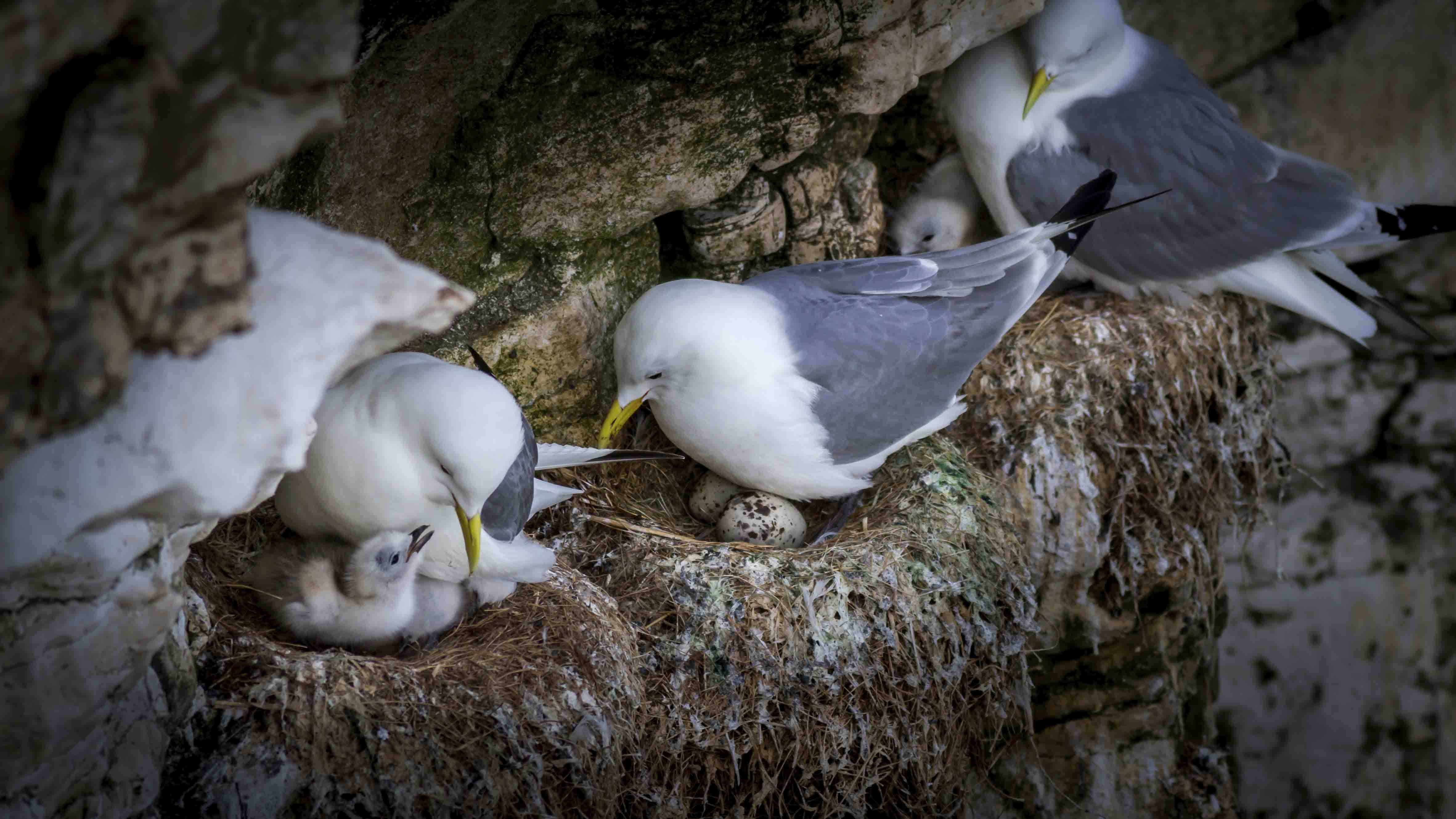
The size and shape of Kittiwake eggs are influenced by a few factors, including the position of the egg in the laying sequence and the breeding experience of the female (Rebecca Cole).
Shell thickness
The thickness of the eggshell is also an important parameter. For most species, the source of the calcium that forms the main component of the eggshell comes from the female's diet. For some species, this involves quite a dramatic switch in diet during the breeding season, in order to ensure that sufficient calcium is ingested to produce the eggshells. An extreme example has been documented in Common Swifts, whereby the females undergo cyclic osteoporosis due to the leaching of calcium from their own bones to provide calcium for eggshell production.
Thicker eggshells are generally more prevalent in species with precocial young (for example, waterfowl) and which breed in open habitats. Not only is eggshell thickness important to ensure a successful breeding attempt, but it also provided pivotal data in studying the toxic effects of the now-banned insecticide, DDT. Using long-term studies and museum eggshell specimens, a decrease in the eggshell thickness of raptors was one of the first indicators of the lethal impacts of DDT. This eggshell thinning had got to the point where incubating parents broke their own eggs. The birds of prey were essentially acting as bioaccumulators, building up high levels of this chemical ingested from their prey. This first indicator of the effects of DDT on bird eggshells played a substantial role in getting the insecticide banned.
The eggshell also plays a fundamental role in governing the exchange of gases across the shell. The correct exchange of gases between the embryo and the outside world – achieved through the diffusive properties of the eggshell – is paramount for the successful development and subsequent hatching of the chick. Eggs lose weight during the incubation process through water loss.
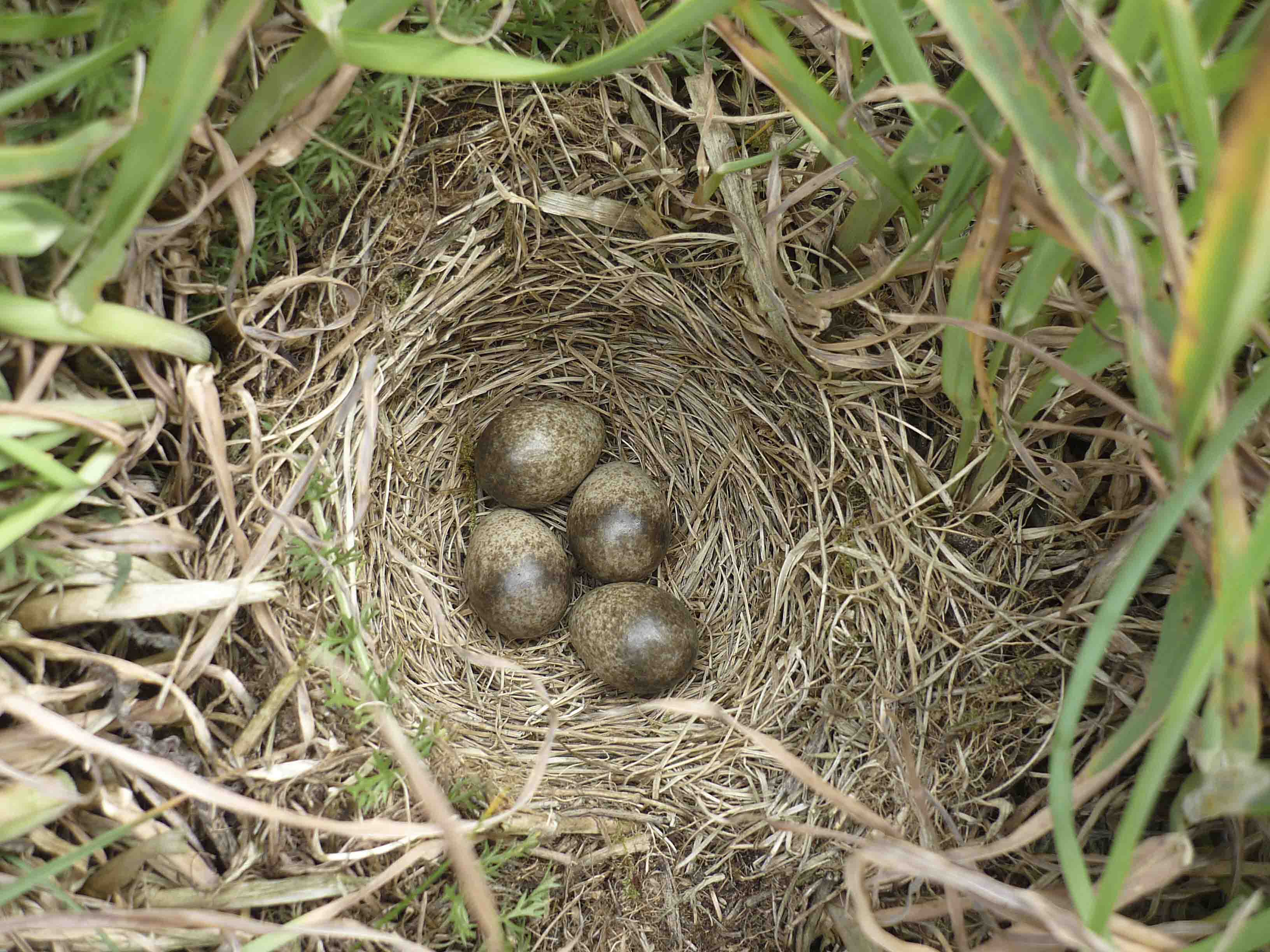
A Eurasian Skylark nest with eggs (Moss Taylor).
This water loss ensures the creation of the air sac. It is this sac that the chick will use for air to breathe once its lungs are developed, but before it has fully hatched and is breathing outside air. A multitude of factors will influence the exchange of gases across the eggshell. Under controlled conditions, the eggs of those species which nest in cavities and burrows – locations which are very humid – exhibit a higher rate of gas exchange, thought to counteract the high humidity of the nest environment. In contrast, the eggs of species which breed in incredibly dry environments, are exposed to high winds, or breed at high altitudes, are more designed to prevent excessive water loss, thus their shells exhibit a lower rate of gas exchange.
Interestingly, eggshells thin throughout incubation. This thinning process is largely due to calcium being leached from the eggshell by the embryo for its developing bones and muscles. This shell thinning also increases the rate of gas exchange as incubation progresses, providing more oxygen as the embryo develops and gets larger.
- This article first appeared in the March 2023 edition of Birdwatch magazine – Britain's best magazine for birders. To be the first to read the magazine each month, take out a subscription to Birdwatch, or get the magazine alongside your bird news by subscribing to either Bird News Ultimate (paper magazine) or Bird News Ultimate Plus (digital access).

